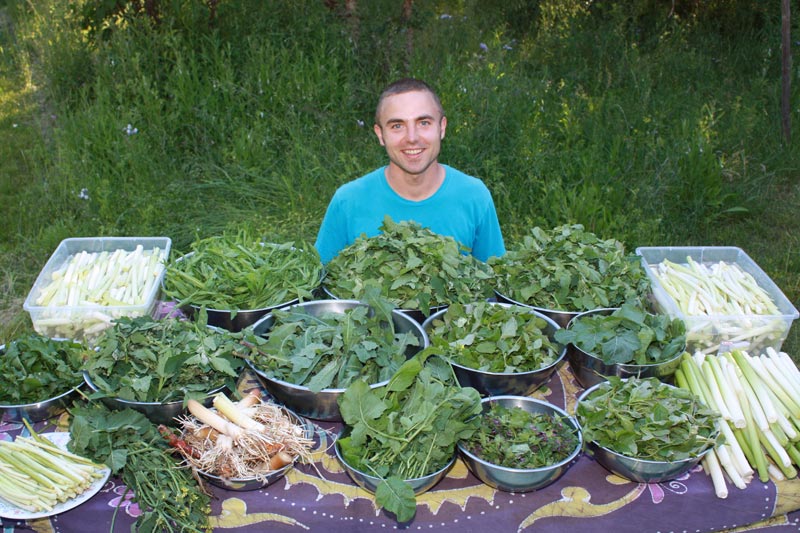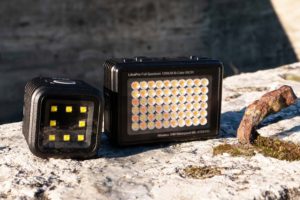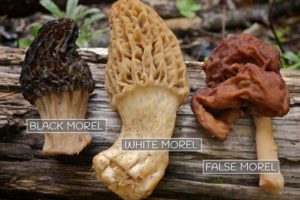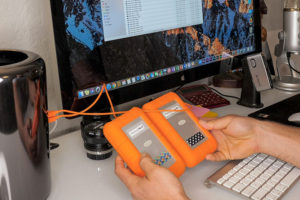Happy springtime! As wild edibles harvesting season approaches, I want to offer some important / straightforward advice that will keep you safe and happy and ensure that your foraging adventures are respectful to the plant life that you encounter. The following excerpt comes from my wild edibles book. Enjoy!
Simple Rules for Foraging
Did you know that donkeys kill more people than airplane crashes each year? On average, 100 people choke to death on ballpoint pens annually. Texting while driving killed 6,000 people in the United States alone in 2011. About 450 Americans will die this year by falling out of bed. Life is full of risks. Harvesting wild edibles presents some inherent dangers as well. Nature is unpredictable. Wild plants do not come with nutritional labels and should be approached with a degree of caution. But foraging is no more dangerous than the million other activities you engage in daily. If you are patient, attentive to your body, willing to educate yourself properly, and able to resist the temptation to eat everything you see, I’m confident that eating wild food will impose no major risk to you. Most of you will find foraging to be extremely pleasant, fun, and healthful. In this section, I would like to discuss a few simple guidelines that should be considered prior to eating new food, whether it is wild or not. Following these rules will greatly minimize your chances of experiencing any negative reactions.
Don’t Eat Something If You Don’t Know What It Is
Most plant poisonings occur when people make no effort to identify what’s in front of them and put unknown vegetation into their mouths. You will be surprised how often this happens. I receive emails more often than I would like from people who eat mysterious wild plants. When they complain about the stomachache they got from consuming an unidentified herb, I have to fight my urge to shout, “Don’t eat something if you don’t know what it is!” (I wrote a song about this and uploaded it to YouTube). While nature is bountiful in edible plants, there are plants that can harm you. Every time you choose to eat a foreign food, you wager your well–being on your decision. Therefore, if you are even slightly hesitant about whether it’s edible, take the appropriate steps to double–check before you take a bite. Create an identification protocol that you feel comfortable with. This process may include bringing the actual plant, or a picture of plant, home for investigation, identifying it with the help of a book or a reputable website, or inquiring with a local expert. I recommend getting in the habit of cross–referencing all new plants with at least two different sources.
Engage Your Senses
When I was an undergrad in college, I learned that the majority of all communication exchanged between people happens non verbally. Like humans, plants have the ability to convey information by how they look, feel, smell, sound, and taste. If we employ all of our senses to listen intently to every form of communication that a plant makes, we can better determine whether it is fit to eat. Engaging all your senses helps to significantly dilute your risk of experiencing an allergic reaction or being poisoned. Many poisonous plants display characteristics that communicate their lack of edibility. Some plants, or plant parts, have very strong, unpleasant odors, while others have tough leaves or sharp thorns. When we engage all of our senses, we can notice such characteristics and avoid the plants or plant parts that will make us sick. I do not recommend for people to forage relying solely on the five basic senses unless they are in an emergency situation. But even if you’re not stranded and starving in the woods, this technique, in addition to the guidance of a credible wild edible book, will help you train your observation skills and plant awareness.
Next time you go foraging, follow these five steps:
1. Look at your surroundings. Notice if any plants appear more tender or edible than others. Even if you’re harvesting a familiar plant, study it and try to figure out which part(s) are suitable for consumption. Notice anything that is not particularly edible (i.e., leaves, sap, thorns, and so forth). Consider the environment you are in. Are there signs saying that chemical sprays have been used in the area? If no signs are posted, but you see plants that are dead or dying for no apparent reason, this could mean pesticides or herbicides may have been used. If unsure, it’s best to harvest from someplace else.
2. Touch everything before you eat it. Sometimes what the eyes miss, the hands see. Use your sense of touch to determine if a plant would be pleasant to consume. Some plants, or plant parts, might appear to be edible, but upon further investigation, your fingers might notice little hairs that can cause irritation. Use your sense of touch as a second pair of eyes to back up your assumptions.
3. Smell everything before eating it. You may need to crush a plant’s leaves or stem to be able to detect its odor. This is a very important step, because a putrid smell often indicates toxicity. On the other hand, some plants have a pleasant aroma that might cause you to salivate. If you notice a strong or unpleasant aroma emitted by a plant, please take extra precautions to determine its edibility.
4. Listen to your surroundings. Become still and try to hear the plants talking to you. This may sound a little crazy, but during my six–month hike from Mexico to Canada, I became more attentive to nature and could hear plants speaking to me. For example, curly dock seeds are encased in a loosely fitting husk that rattles in the wind. There were many times when I would have walked by dock without noticing had I not heard its gentle clatter. Even if a plant doesn’t make a peep, see if you can detect any other sounds that could potentially jeopardize its edibility. Listen for automobiles, roadways, pets, people spraying chemicals, and other potential sources of contamination.
5. Taste only a small amount of anything you pick for the first time. If you want to be even more cautious, you can rub a little piece of a plant on your lip or under your tongue prior to tasting it. Both these areas are extremely sensitive and will alarm you if the plant is toxic. Make sure you give your body time to react. Allow fifteen to twenty minutes to elapse from the moment you taste a new plant. Once you know how your body reacts to it, you can eat more of it.
Start Small
As a newbie forager, many wild edibles will be foreign to you. As adults, we rarely experiment with new foods, which is exactly what we do when we begin eating foraged fare. Just as some people are allergic to peanuts, some wild edibles may cause allergic reactions to any individual. When I say that dandelions are completely edible, don’t just take my word for it. Conduct your own experiment to make sure. The best way to avoid suffering any unpleasant symptoms is to approach new food cautiously and in small proportions. As mentioned earlier, engaging your five basic senses when experimenting with new food is incredibly helpful.
Don’t Mix Weeds
Once, at the start of my wild edible exploration, I made a salad out of seventeen different ingredients. I chopped up wildly harvested salsify, miner’s lettuce, and wild radish, along with other greens, and dressed them with olive oil, lemon juice, and salt. I had never tried several of the edibles in my salad prior to that point. I ate the entire bowl and shortly thereafter broke out in hives. I made sure to drink lots of water to flush out whatever I was allergic to. Nevertheless, the experience shook me up. Though it was a relatively mild reaction, it is not something I’d care to repeat. On the bright side, I learned a valuable lesson that day. I understood the importance of easing new foods into my diet one by one.
I recommend not mixing newly discovered wild edibles. If you combine too many ingredients in a recipe and have a reaction, you won’t know which plant caused it. Instead of mixing your weeds, consume one wild edible at a time until you are absolutely sure how your body will react.
Educate Yourself
Knowledge is power! The best way to stay safe is through good old–fashioned education. Reading a good book will help you grasp nuances that will make your foraging experience more enjoyable. Attending a hands–on wild foods workshop is a great way to learn about plants as well. The internet is also a valuable tool for identification, but you should never make conclusions solely on what you read on the net. Anybody with a computer can post anything, any time. It is a good idea to cross–reference any and all information about wild edibles with several other sources. After all, it’s only your life we’re talking about.
Follow the Baby Greens Rule
All greens taste best when they are young. New leaves are generally more tender than mature ones and contain higher concentrations of protein and sugar. These factors make young plants and plant parts more enjoyable and more nutritious. As a forager you will need to know how to identify meristems in order to get the maximum amount of enjoyment and health out of your meal.
The term meristem was coined by Swiss botanist Karl Wilhelm von Nägeli in 1858. Nägeli discovered that certain groups of plant cells were capable of division and called these parts meristems, from the Greek word for “divided.” Meristems are the parts of a plant where growth occurs. During cell division, the tissue of a plant will need to shift or expand, so plants supply growing parts with constant nutrients so that they will remain flexible for growth to occur. Thus the young, growing parts of plants are always more tender and taste better than the older, fibrous parts.
How do you find a meristem? When a plant is young it’s easy. New flora is likely to consist entirely of flexible, growing parts. This means that the whole plant is a meristem. As a plant develops, however, it becomes increasingly difficult to identify which parts are newly formed. Generally, as a plant matures, the lower parts closest to the ground begin to harden, in order to support the growth taking place above. These hard sections are not meristems, as they no longer experience stretching or widening. It can be helpful to note such fibrous parts, as they are the exact opposite of what you’re looking for. When looking for meristems on mature vegetation, try searching near the tops and tips of the plant. For example, in late summer, the stinging nettles patch near my house reaches its peak height of about seven feet. If I try to harvest the bottom leaves from such mature nettles for a smoothie, my drink will be extremely bitter and tough to blend. On the other hand, using leaves from the top two feet of the nettles guarantees a delicious smoothie, because I am using new growth (meristematic parts).
Here are a few easy ways to spot meristems:
• These parts are often a different color.
• Their hue is usually a lighter green than other portions of the plant.
• These parts break and bend more easily.
• Meristematic leaves are generally smaller than mature ones.
• These parts can lack the hairs or thorns of mature plants.
• These parts usually grow in tighter clusters.
• These parts may be folded or curled, unlike other leaves.
Respect the Roots
Many edible plants have roots that are both delicious and edible. I make note of this in the field guide chapter of this book. From time to time I like to indulge in these earthy treats. However, for the majority of my harvests, I prefer to stick to fruits and greens. These parts are nutritionally superior to roots and are much easier to harvest and eat. Additionally, harvesting roots often ends a plant’s life and prevents other creatures from enjoying its bounty. Thus, I stick to what grows above the ground and on rare or special occasions eat roots.

Let's go foraging together!
I’ve been gathering wild plants since I was 13, when, early on in a 6-month hike from Mexico to Canada my family and I ran out of provisions and turned to foraging for survival in the wild. Back in civilization, I became dismayed by the inferior quality of store-bought food and industrial agriculture, and began to regularly collect wild plants near my home and on my travels. I share knowledge gleaned from years of wildcrafting and thriving in my wild edibles book.



